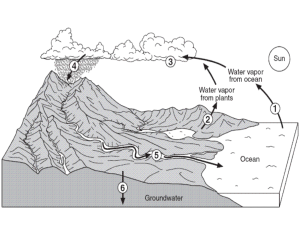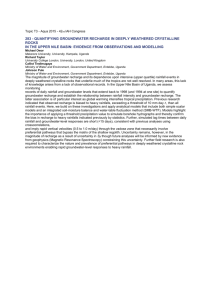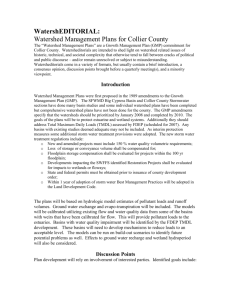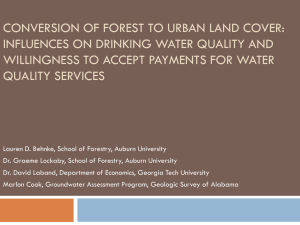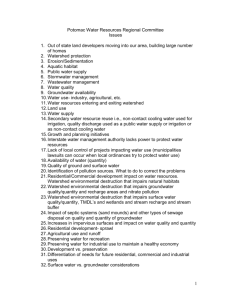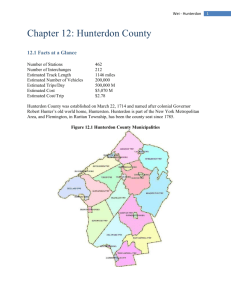Hunterdon County Smart Growth Joint Natural Resources/Land Use
advertisement
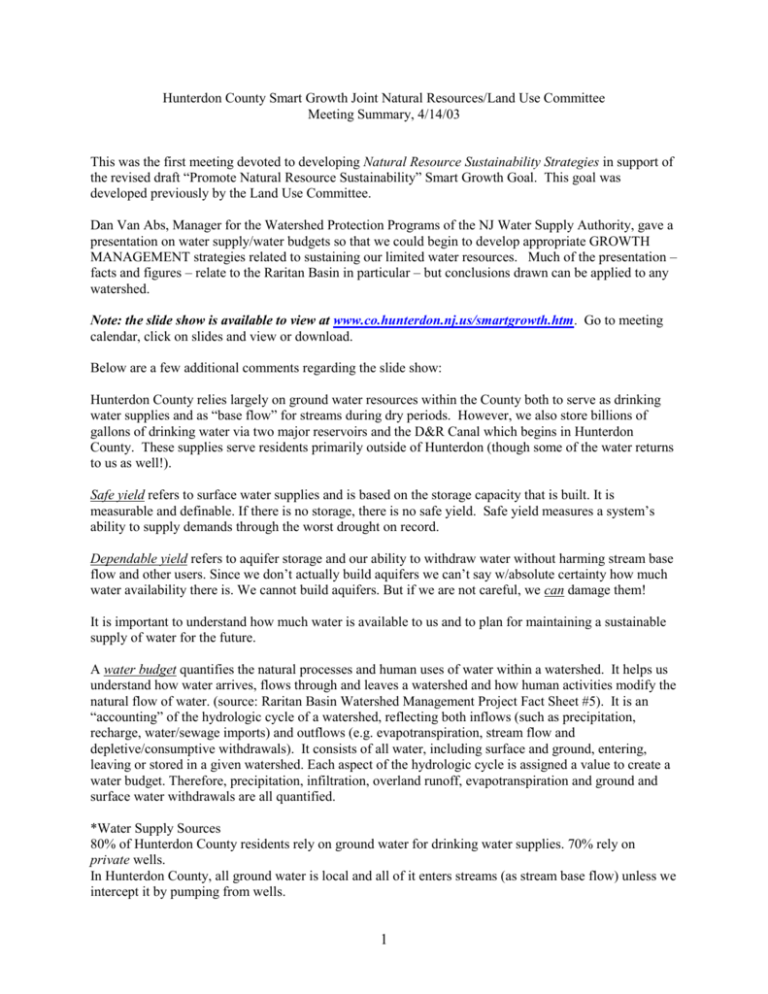
Hunterdon County Smart Growth Joint Natural Resources/Land Use Committee Meeting Summary, 4/14/03 This was the first meeting devoted to developing Natural Resource Sustainability Strategies in support of the revised draft “Promote Natural Resource Sustainability” Smart Growth Goal. This goal was developed previously by the Land Use Committee. Dan Van Abs, Manager for the Watershed Protection Programs of the NJ Water Supply Authority, gave a presentation on water supply/water budgets so that we could begin to develop appropriate GROWTH MANAGEMENT strategies related to sustaining our limited water resources. Much of the presentation – facts and figures – relate to the Raritan Basin in particular – but conclusions drawn can be applied to any watershed. Note: the slide show is available to view at www.co.hunterdon.nj.us/smartgrowth.htm. Go to meeting calendar, click on slides and view or download. Below are a few additional comments regarding the slide show: Hunterdon County relies largely on ground water resources within the County both to serve as drinking water supplies and as “base flow” for streams during dry periods. However, we also store billions of gallons of drinking water via two major reservoirs and the D&R Canal which begins in Hunterdon County. These supplies serve residents primarily outside of Hunterdon (though some of the water returns to us as well!). Safe yield refers to surface water supplies and is based on the storage capacity that is built. It is measurable and definable. If there is no storage, there is no safe yield. Safe yield measures a system’s ability to supply demands through the worst drought on record. Dependable yield refers to aquifer storage and our ability to withdraw water without harming stream base flow and other users. Since we don’t actually build aquifers we can’t say w/absolute certainty how much water availability there is. We cannot build aquifers. But if we are not careful, we can damage them! It is important to understand how much water is available to us and to plan for maintaining a sustainable supply of water for the future. A water budget quantifies the natural processes and human uses of water within a watershed. It helps us understand how water arrives, flows through and leaves a watershed and how human activities modify the natural flow of water. (source: Raritan Basin Watershed Management Project Fact Sheet #5). It is an “accounting” of the hydrologic cycle of a watershed, reflecting both inflows (such as precipitation, recharge, water/sewage imports) and outflows (e.g. evapotranspiration, stream flow and depletive/consumptive withdrawals). It consists of all water, including surface and ground, entering, leaving or stored in a given watershed. Each aspect of the hydrologic cycle is assigned a value to create a water budget. Therefore, precipitation, infiltration, overland runoff, evapotranspiration and ground and surface water withdrawals are all quantified. *Water Supply Sources 80% of Hunterdon County residents rely on ground water for drinking water supplies. 70% rely on private wells. In Hunterdon County, all ground water is local and all of it enters streams (as stream base flow) unless we intercept it by pumping from wells. 1 For planning purposes, the 1996 NJ Statewide Water Supply Plan assumed that 20% of ground water recharge is available for human use w/out unacceptable impacts to the aquifer. This figure is based on regional impacts to very large aquifers, not local impacts. *Spruce Run and Round Valley Reservoirs are operated by the NJ Water Supply Authority and have a combined capacity of 66 billion gallons. Spruce Run Reservoir is fed by natural stream flow while Round Valley is reliant mostly on water pumped from the South Branch Raritan at the Hamden Pumping Station. Water released from either reservoir travels downstream to maintain flow at the intake of Elizabethtown Water Company outside of Hunterdon Co. and at the intakes of other users. NJDEP must ensure that water quality of water sources is maintained and that water standards for various uses of water are met. In part, it addresses this by mandating that water withdrawals be limited to levels that do not excessively drain surface or ground waters. The way to do this via surface waters is through “passing flows.” For intakes not associated with reservoirs, a passing flow is established below which withdrawals are not allowed. A “release flow” is established for reservoirs to ensure that downstream flows are maintained at a certain level. Maintaining this flow provides usable water for users downstream and also protects aquatic life. These passing and release flow levels are major factors in determining how much water is available for use in a watershed. The higher the passing or release flows, the less water is available for users during dry periods. (Note: this paragraph was taken from the NJ Water Supply Authority, Sept 2000 report titled “Water Supply Availability in the Raritan River Basin” as further explanation of certain terms used in the powerpoint presentation given on April 14, 2003). *Hunterdon Aquifers The Sourland Mtn/Cushetunk Mtn are underlain by diabase – a very dense rock; poor aquifer recharge; not appropriate location for public well water The Piedmont consists typically of fractured shale and can be a good community water supply source. However, portions of the Piedmont in Hunterdon County (e.g. the Stockton and Lockatong formations) are not good supplies and local streams often run dry for that reason. Limestone, found in Highlands, is the most prolific source of ground water but also the most vulnerable (e.g. contamination). *Runoff, Changes in Land Use Land uses that decrease evapotranspiration (such as deforestation) and reduce infiltration (such as effective impervious surfaces) increase runoff, thereby contributing to increased flood levels. The percentage of stream flow that is comprised of base flow and runoff can be changed by land uses that reduce recharge by increasing runoff (e.g. soil compaction, pavement, etc) *Hunterdon Streams Nontrout streams are not necessarily dirtier than trout streams. The only difference is temperature: nontrout streams are too warm to support trout. *Infiltration ~ Base flow Over a long period of time, infiltration is approx. equal to base flow unless we draw water out to wells. Over short periods, the two may vary a great deal. *Stream flow = Baseflow + Runoff Within the Raritan Basin, over 50% of water that falls as precipitation is returned to the atmosphere via evapotranspiration. Only about 25% infiltrates into the ground. The Stony Brook (Millstone River tributary) is a good example of a naturally “flashy” stream. Why? Because water runs off the Sourland Mtn during rain events, causing water levels to rise dramatically. But between storm events, because the Mtn is underlain by dense, poorly fractured rock, it doesn’t hold much 2 ground water in the rock. Therefore, not as much water is available to recharge as stream baseflow during dry periods. So the stream runs very dry during dry periods and rises dramatically during rain events. *Water Budget Changes We do not have a natural hydrologic cycle. What changes the natural flow? -withdrawals -transfers -consumptive uses: e.g. some industries take water, use it and then it evapotranpires. Only 80% of water used in households and then put into domestic septic systems returns to the ground as recharge. -reduced recharge rates -increased runoff -reduced evapotranspiration When you reduce recharge, you increase runoff, enlarge the flood plain and change the stream channel (it is cut down and it is cut out; the banks become steep, eroded.) Water budgets are usually expressed as annual averages. They are a good tool for helping to guide local zoning/planning but are not useful for lot/site-specific design…the information is not specific enough! Also, average conditions are not appropriate for streams that experience extreme conditions. When planning accordingly, you must first define the issue. Then you need to figure out your budget. *Ground Water Recharge Change Between 1986 and 1995, subwatersheds in the Raritan Basin experienced losses in ground water ranging from 10% to 25%; the majority of Hunterdon County losses ranged from 0 to 10%. *Projected Water Demands Within the Raritan Basin, surface water demand projected to the year 2040 will exceed available supply! Ground water demands can exceed local supplies in a shorter time frame as proven recently during the drough. *NJDEP Water Budget Project The NJDEP is preparing a water budget analysis down to the HUC 11 level (a watershed unit of roughly 50 to 100 square miles) as part of its new Statewide Water Supply Plan. The project should be completed in 2004. The water budget will locate and document the size of all permitted water withdrawals in the State, estimate ground water recharge, and estimate flow needs for aquatic ecosystems. For municipal planning purposes, it would be good to bring the results to a subwatershed scale (HUC 14), which is possible using a method developed for the Raritan Project (Strategy RB-S3, at www.raritanbasin.org/management_plan.htm). 3 Summary of Strategies/Recommendations Dan Van Abs raised several critical growth management questions at the end of the powerpoint presentation. Those in attendance then jotted down strategies/recommendations for maintaining a sustainable water supply in Hunterdon County. The questions posed were as follows: 1. Do we rely on local resources or import? At what scale? 2. How much do we depend on surface vs. ground water resources? 3. If we rely on ground water, how conservatively should supplies be estimated? 4. What level of knowledge is sufficient? 5. What are appropriate roles for conservation, recycling and reuse of water? 6. What level of aquatic ecosystem protection should be accorded? 7. What are the implications for master plans? The following are responses generated by those in attendance. There was no need to identify who said what. However, since I felt compelled to jot down my own ideas as well, I have distinguished them from those of committee members since I am the facilitator, and not technically a committee member! Encourage development in the areas of the county that the [NJGS] nitrate dilution model recommends in terms of recommended lot sizes. Hunterdon County residents are efficient water users, as we recycle about 80% of the water we use. Therefore we are entitled to more of our water resources. Urban areas conserve little, recharge little, generate high levels of impervious cover, and discharge polluted stormwater into surface water bodies. Control growth below the watershed areas, not just in the watershed areas. Set up better and not politically reliant ways of funding for watershed protection purchasing. Admit that we in the Highlands are suppliers of water, not primary users. We use less than 1% of the rainfall we receive. Admit that public water companies service customers (cities) are virtually 100% depletive users. They recharge nothing. Do we want to subsidize this kind of planning? Re-use water for golf courses, etc. Charge more for water to reduce its use. Charge water users a higher fee than NJWSA currently does (currently $5/mgd) to preserve watershed lands. Emphasize conservation, recycling and reuse to minimize drawing down supplies. It is a municipal responsibility to protect watersheds for “downstream” citizens. Increase base flow collection data along streams for more local planning use. Land development projects should be environmentally/water friendly – ensure this through the land development process. Wellhead protection strategies should be adopted by municipalities to protect existing water supplies. Karst/limestone ordinance should be adopted to address land use and development risks in karst areas. Water conservation rules/regulatory programs should be adopted for water irrigation systems. These should be based on weather-rainfall-climate factors. When safe yields are established [through the State’s water budget project], municipalities should be reassessed/evaluated based on “build out analysis.” Develop a system to regionally review water supply allocation permit process and impacts on local resources [e.g. Garden State Growers]. Stream monitoring is needed on a regular basis. Protect streams by creation of berms where necessary. 4 Protect stream beds by increasing buffers to prevent agricultural runoff into streams. Increase authority of the river master to police point dischargers into the Musconetcong and Raritan Rivers. Educate public, governing bodies, school children, etc. Smart growth needs to be directly linked to water supply and waste treatment facilities. Concentrations cannot outstrip supplies. Farmland preservation needs to be directed more towards woodlands (recharge) preservation. Many farmers are now retiring. Talking to landowners in Hunterdon, it is becoming increasingly difficult to find people to farm their fields. From a water recharge perspective, woodlands are far more valuable. Farm fields have a great deal of runoff. Clear goals for conservation areas surrounding critical recharge areas is needed. Include critical habitats of plants/ecosystems. Work across municipal boundaries to reach comprehensive planning goals that will conserve water that may not follow political boundaries. Particularly land use on municipal boundaries should correlate to conserve water and habitats. Best Management Practices for ground water recharge and surface water runoff are needed. Use mostly nonstructural measures to reduce impervious surfaces. Limit watering lawns and car washing (esp. in the summer). Limit further domestic wells and public water supplies. Conduct better and more comprehensive impact analyses. Disconnect homeowners’ gutters and promote ground water recharge. Promote rain barrels for homeowners. Promote gray water re-use for homeowners/commercial uses Monitor/track illicit drawdowns of streams. See if sewage treatment plants can do more with gray water re-use. Look at water allocation permit program and potentially recommend changes. Promote less impervious lawns – promote recharge. As the Highlands region relies on ground water, water budgeting and future conservation planning are essential for municipal level master plans. Build out analysis is needed along with more accurate residential usage rates considering modern home size and increased landscaping demands from large lot zoning. Establish baseline data on the ability of natural systems to maintain water quality and provide flood control. Emphasize resources that increase infiltration and contribute to base flow. Consider lowering the threshold usage rate for allocation permitting. Make suggestions for mandatory water conservation methods. Recognize that when planning based on water budgets, there is a degree of uncertainty in estimating parameter values (hydrogeologic properties) and uncertainty in predictive models (e.g. demographic change and ground water flow). Need to define what areas can support septic systems and at what density and those areas that cannot. Must address wastewater when we plan for water supply. Good planning and smart growth should have a heavy emphasis on conservation and use minimization when it comes to water. In addition to the obvious drought and aquifer depletion issues, less water used means less wastewater produced. County and municipalities should strongly consider the impact of future growth and development on stormwater quality and quantity vis-à-vis the new state stormwater regs. Evaluate public water and systems to identify infrastructure conditions and repair needs. Prepare programs for necessary infrastructure maintenance and repair. Consider cost and effectiveness of potential infiltration and inflow reductions as part of any considerations of expanding treatment plant capacity. 5 Expand septic management and well testing programs in areas served by on site wastewater systems and residential wells. For areas w/septic system problems, consider new technology, such as package treatment plants. Evaluate public costs for ensuring safe dependable water supplies. Further increases in surface water pollution could increase the cost of drinking water treatment, the need to close intakes or the need to build new treatment facilities. Advance watershed management planning and other initiatives to improve and protect water and air quality. Encourage compliance w/local, state and federal environmental regulations and strengthen monitoring and enforcement programs. Retain enough natural and undeveloped land area to filter and recharge ground and surface water resources and assure adequate drinking water supplies. Use water recycling and other conservation strategies to enhance water supply and minimize drought impacts. Need package of incentives for landowners to help conserve and protect water resources. --------------------------------------------------------------------------------------------------------------------Caroline’s observations: Overall objective - maintain sustainable watersheds within Hunterdon County that address needed water uses while maintaining ecosystem health by planning locally to achieve no net detrimental change in either natural surface runoff or infiltration. (Gist of this statement was taken from the Raritan Basin Plan!)…quite the ambitious objective. Is it realistic????? This requires a detailed and reliable water budget prepared down to the HUC 14 (subwatershed) level and planning actions to stay within these budgets. Caroline’s responses to the 7 questions raised by Dan Van Abs (see p. 4): Question #1&2: Sustainability should be addressed at the watershed level. Inter-basin transfer of water and consumptive/depletive uses impact on watersheds. We should be relying predominantly on water supplies from within and, from a growth management standpoint, on our own ground water resources. However, 1. should municipalities want to pursue “center-based” development within the County’s watersheds as a way to help preserve large expanses of land (through transfer of development rights), thereby contributing to significant recharge and 2. the center-based density cannot be supported by local ground water supplies, then 3. perhaps we should support inter-basin transfers in this case (i.e. do the benefits outweigh the detriment?) so long as they are within the Statewide water budget determinations. Question #3: For local planning purposes, we should generally be conservative in our estimates of available water to ensure adequate supplies in the long run. Look at available water supply based both on long-term average precipitation/recharge and also on drought conditions, determine the range, and plan accordingly. Perhaps we should err toward conservative estimates in subwatersheds we deem “sensitive.” Examples might include Category One waters (those so deemed because of particular ecological or drinking water supply value), nondegradation areas (designated by the State), prime aquifer recharge areas (areas where good ground water recharge overlap with prolific aquifers), or watersheds of streams feeding our major surface water supplies. Also, await State’s water budget results to see how this issue is addressed. State currently uses a 20% threshold (20% of recharge) for the percent of ground water recharge available for human use w/out unacceptable impacts to the aquifer. Is this sufficient? State should reexamine 20%, particularly given the length and severity of recent drought (despite the fact that it wasn’t as severe as drought of record) to determine its appropriateness. The 2002 Highlands Regional Study suggests 10% might be a better threshold, at least for the Highlands region. IN either case, these thresholds are intended for larger, regional impacts to very large aquifers, not local impacts. We need to find tools/thresholds for municipal planning purposes that allow us to address smaller subwatersheds. 6 Question #4: The State’s water budget project will “drill down” to the HUC 11 level for the development of water budgets. For data to be useful at the municipal/county planning levels, need to bring this down to the HUC 14 level (smaller subwatersheds). Therefore, County should provide the necessary additional data to allow for a water budget analysis down to the HUC 14 level. Other data may also need to supplement the water budget information for local planning purposes, such as existing land use/land cover, impervious cover, etc. Impacts of impervious surfaces on stream base flow should be modeled for the Piedmont region, using the method implemented in the Highlands region (alternatively, the entire county should be modeled using a method recommended through the State’s water budget project if deemed more appropriate than the Highlands method). Municipalities should then plan/regulate accordingly so that new development achieves no net detrimental changes in either natural surface runoff or infiltration. Among the techniques for doing so are stormwater management (recharge and water quality in concert w/anticipated state regs), management of impervious cover and forest removal, and reduced soil compaction. Note: impervious cover management is not as important on a site-specific basis, perhaps, as it is on a watershed-wide (HUC 14) basis. Also, to plan appropriately for the future, municipalities should conduct buildout analyses, projecting anticipated growth and water usage to ensure ground water supplies can meet projected growth. If buildout analysis suggests that demand may exceed availability, then measures should be adopted to mitigate this impact. Question #5: Municipalities/county should aggressively reach out to the public to promote water conservation. From a regulatory perspective, stormwater management requirements, if adopted by the State, should help in addressing both water recharge and water quality control at the local level. Question #6: Municipalities and county should encourage State to maintain (increase?) stream flow/quality monitoring sites. Municipal environmental commissions and watershed organizations should follow accepted QA/QC procedures for water quality monitoring and NJDEP should utilize their data to help establish appropriate levels of aquatic protection. Since ground water provides a significant portion of base flow to streams, maintaining a high level of ground water quality is equally important. Planning tools, such as nitrate dilution modeling, are important means of tackling this issue. Septic system management is also very important and communities/county should pursue public education programs to encourage proper maintenance of septic systems. County should help disseminate information acquired from Health Dept, ANJEC and other sources on creative approaches to septic system management. Upon completion of its water budget analysis, the State should ensure that all water allocations are consistent w/these water budgets. Question #7: Master plans should reflect importance of water supply, limitations and water budgets down to HUC 14 level. Municipalities and county should plan for water supply protection at the HUC 14 level, which in some cases demands inter-municipal cooperation (since subwatershed boundaries do not necessarily coincide w/political boundaries). Master plan conservation elements should provide the necessary background data/information and analysis as well as policies for land use planning that reflect desire to achieve a no net detrimental change in either natural surface runoff or infiltration. This may involve regulations for “major” activities that require an analysis of anticipated impacts o f new development on water budgets (e.g. as part of the environmental impact assessment). Regulations should be developed to the best of our ability, based on available science-based information. However, they should not be unduly onerous but fair and practical. Also, water supply analysis should be a fundamental component of wastewater management plans, planning documents that all municipalities should adopt and have approved by the NJDEP. 7
